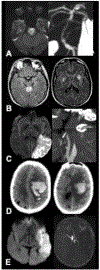Prognostication in Acute Neurological Emergencies
- PMID: 35007934
- PMCID: PMC8837701
- DOI: 10.1016/j.jstrokecerebrovasdis.2021.106277
Prognostication in Acute Neurological Emergencies
Abstract
Background: For patients with acute, serious neurological conditions presenting to the emergency department (ED), prognostication is typically based on clinical experience, scoring systems and patient co-morbidities. Because estimating a poor prognosis influences caregiver decisions to withdraw life-sustaining therapy, we investigated the consistency of prognostication across a spectrum of neurology physicians.
Methods: Five acute neurological presentations (2 with large hemispheric infarction; 1 with brainstem infarction, 1 with lobar hemorrhage, and 1 with hypoxic-ischemic encephalopathy) were selected for a department-wide prognostication simulation exercise. All had presented to our tertiary care hospital's ED, where a poor outcome was predicted by the ED neurology team within 24 hours of onset. Relevant clinical, laboratory and imaging data available before ED prognostication were presented on a web-based platform to 120 providers blinded to the actual outcome. The provider was requested to rank-order, from most to least likely, the predicted 90-day modified Rankin Scale (mRS) score. To determine the accuracy of individual outcome predictions we compared the patient's the actual 90-day mRS score to highest ranked predicted mRS score. Additionally, the group's "weighted" outcomes, accounting for the entire spectrum of mRS scores ranked by all respondents, were compared to the actual outcome for each case. Consistency was compared between pre-specified provider roles: neurology trainees versus faculty; non-vascular versus vascular faculty.
Results: Responses ranged from 106-110 per case. Individual predictions were highly variable, with predictions matching the actual mRS scores in as low as 2% of respondents in one case and 95% in another case. However, as a group, the weighted outcome matched the actual mRS score in 3 of 5 cases (60%). There was no significant difference between subgroups based on expertise (stroke/neurocritical care versus other) or experience (faculty versus trainee) in 4 of 5 cases.
Conclusion: Acute neuro-prognostication is highly variable and often inaccurate among neurology providers. Significant differences are not attributable to experience or subspecialty expertise. The mean outcome prediction from group of providers ("the wisdom of the crowd") may be superior to that of individual providers.
Keywords: Brain injury; Neurological emergencies; Neuroprognostication; Outcome prediction.
Copyright © 2021 Elsevier Inc. All rights reserved.
Figures


Similar articles
-
Cerebellar Infarction and Factors Associated with Delayed Presentation and Misdiagnosis.Cerebrovasc Dis. 2016;42(5-6):476-484. doi: 10.1159/000448899. Epub 2016 Aug 27. Cerebrovasc Dis. 2016. PMID: 27576326
-
Prognostication of ICU Patients by Providers with and without Neurocritical Care Training.Neurocrit Care. 2022 Aug;37(1):190-199. doi: 10.1007/s12028-022-01467-6. Epub 2022 Mar 22. Neurocrit Care. 2022. PMID: 35314970
-
Doctors and nurses subjective predictions of 6-month outcome compared to actual 6-month outcome for adult patients with spontaneous intracerebral haemorrhage (ICH) in neurocritical care: An observational study.eNeurologicalSci. 2023 Dec 22;34:100491. doi: 10.1016/j.ensci.2023.100491. eCollection 2024 Mar. eNeurologicalSci. 2023. PMID: 38274038 Free PMC article.
-
Systematic reviews of the effectiveness of day care for people with severe mental disorders: (1) acute day hospital versus admission; (2) vocational rehabilitation; (3) day hospital versus outpatient care.Health Technol Assess. 2001;5(21):1-75. doi: 10.3310/hta5210. Health Technol Assess. 2001. PMID: 11532238 Review.
-
[Focal point emergency departments].Nervenarzt. 2016 Jun;87(6):592-602. doi: 10.1007/s00115-016-0116-y. Nervenarzt. 2016. PMID: 27167888 Review. German.
Cited by
-
A Clinical Neuroimaging Platform for Rapid, Automated Lesion Detection and Personalized Post-Stroke Outcome Prediction.medRxiv [Preprint]. 2025 May 11:2025.05.09.25327310. doi: 10.1101/2025.05.09.25327310. medRxiv. 2025. PMID: 40385411 Free PMC article. Preprint.
-
The Recovery of Consciousness via Evidence-Based Medicine and Research (RECOVER) Program: A Paradigm for Advancing Neuroprognostication.Neurol Clin Pract. 2024 Dec;14(6):e200351. doi: 10.1212/CPJ.0000000000200351. Epub 2024 Aug 16. Neurol Clin Pract. 2024. PMID: 39185092 Free PMC article.
-
Machine learning predictors of risk of death within 7 days in patients with non-traumatic subarachnoid hemorrhage in the intensive care unit: A multicenter retrospective study.Heliyon. 2023 Dec 16;10(1):e23943. doi: 10.1016/j.heliyon.2023.e23943. eCollection 2024 Jan 15. Heliyon. 2023. PMID: 38192749 Free PMC article.
-
Effect of connective tissue growth factor and inflammatory factors on the condition and prognosis of patients undergoing reperfusion for acute ischemic stroke.Am J Transl Res. 2024 Nov 15;16(11):7155-7164. doi: 10.62347/BRAE1229. eCollection 2024. Am J Transl Res. 2024. PMID: 39678567 Free PMC article.
References
-
- Rost NS, Smith EE, Chang Y, Snider RW, Chanderraj R, Schwab K, et al. Prediction of functional outcome in patients with primary intracerebral hemorrhage: The FUNC score. Stroke. 2008;39(8):2304–9. - PubMed
-
- Hemphill JC, Bonovich DC, Besmertis L, Manley GT, Johnston SC. The ICH Score. Stroke. 2001;32(4):891–7. - PubMed
-
- Saposnik G, Kapral MK, Liu Y, Hall R, O’Donnell M, Raptis S, et al. IScore: A risk score to predict death early after hospitalization for an acute ischemic stroke. Circulation. 2011;123(7):739–49. - PubMed
-
- Quinn T, Moskowitz J, Khan MW, Shutter L, Goldberg R, Col N, et al. What Families Need and Physicians Deliver - Contrasting Communication Preferences between Surrogate Decision- Makers and Physicians during Outcome Prognostication in Critically-Ill TBI Patients. Neurocritical. 2017;27(2):154–62. - PMC - PubMed
MeSH terms
Grants and funding
LinkOut - more resources
Full Text Sources
Medical

